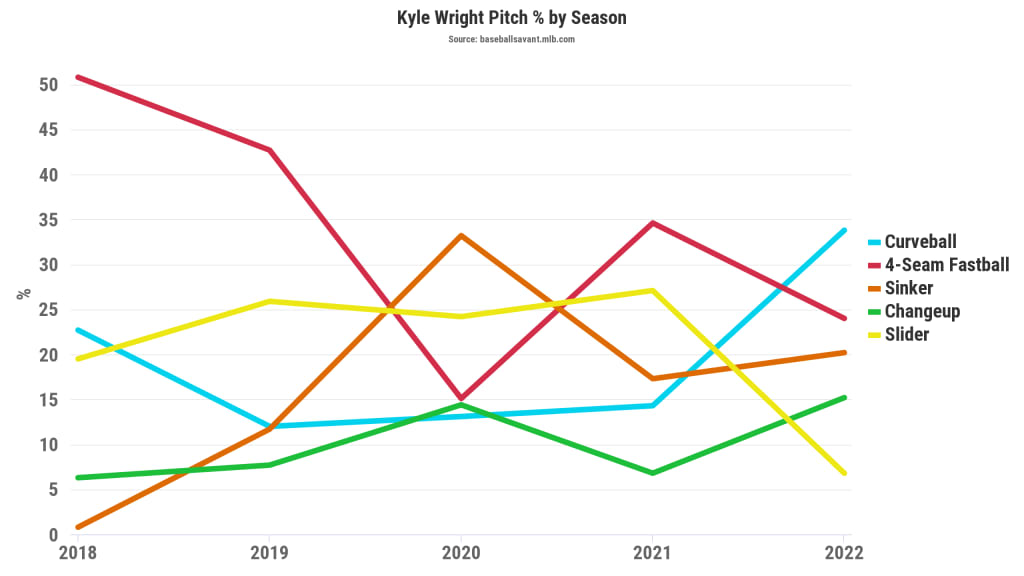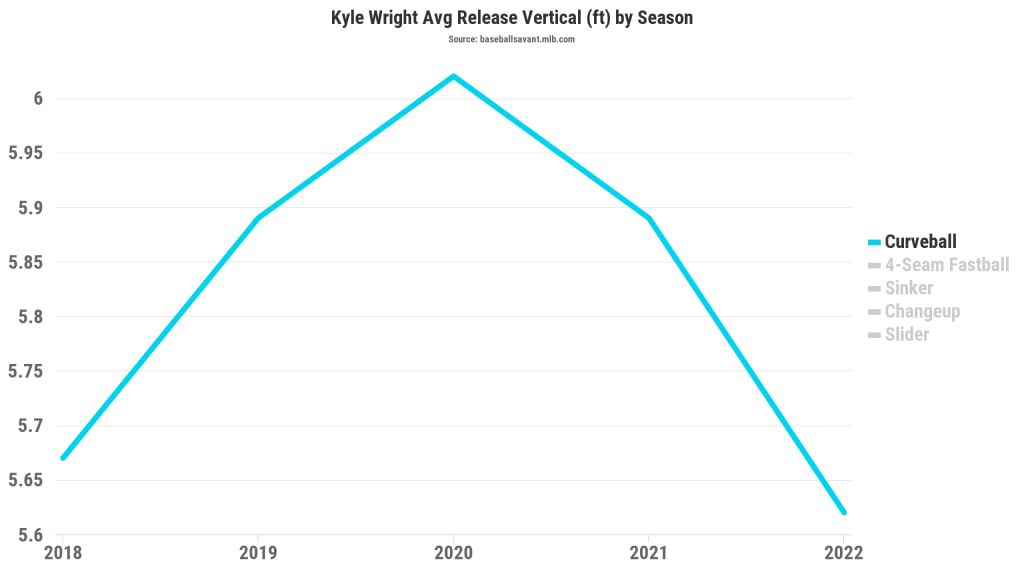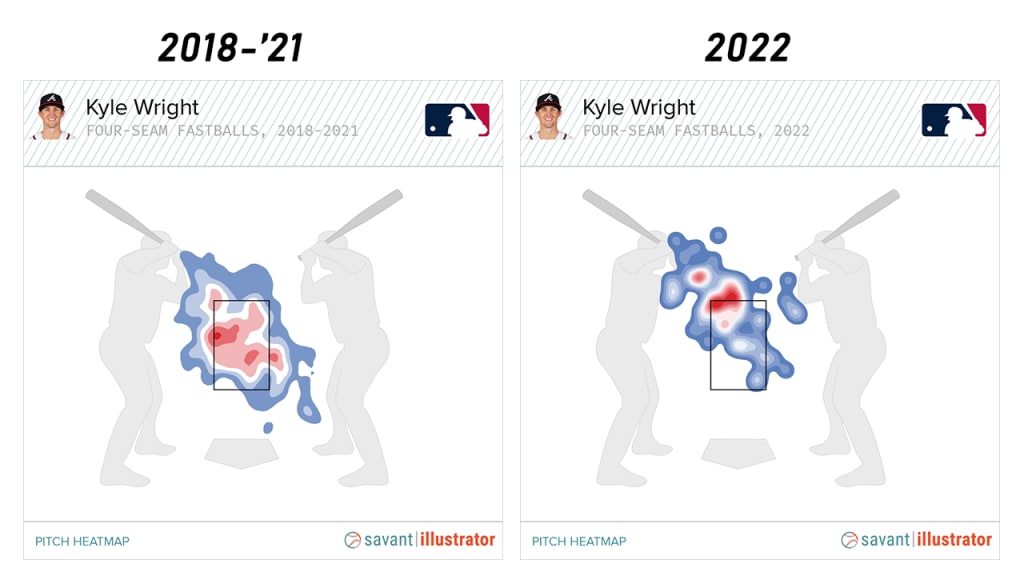Kyle Wright was the No. 5 overall pick in the 2017 Draft, and barely more than a year later, he was a Major Leaguer, making Jackie Bradley Jr. lose his bat for his first career strikeout. The next year, he made the Braves' Opening Day rotation. At 23, it seemed like the path to stardom was clear.
Spoiler alert: It was not! Wright made three ineffective starts (7.07 ERA) in 2019 before being demoted; he came back up in July to give up seven runs, and back down he went. In 2020, he made eight inconsistent starts, posting a 5.21 ERA. In 2021, he was barely in the picture at all, spending nearly the entire regular season in the Minors, popping up only to allow seven runs in two short starts. His career ERA sat at 6.56 -- though he did resurface to throw 5 2/3 stunning innings of one-run ball in the World Series. (We’ll get back to that in a minute.)
It was easy, at the time, to lose track of him. While the Braves have had success developing Max Fried and Ian Anderson, they, like all clubs, have had their share of pitching struggles too. There are names who blossomed elsewhere or not at all or at least not yet, the collection made up of Bryse Wilson, Kolby Allard, Kyle Muller, Huascar Ynoa, Lucas Sims, Touki Toussaint and others. Lofty Draft position aside, it was easy to wonder if Wright would be a member of the latter group, not the former.
Three starts into the 2022 season, his fifth in the Majors, one in which he had to battle for a back-end rotation spot just a month ago, Wright has a 1.06 ERA. He’s struck out 26 of the 66 batters he’s faced -- that’s nearly 40% -- and walked just two. It’s not small-sample flukishness, either; among pitchers who have faced 50 hitters, the underlying Statcast metrics have him as baseball’s second-best regular pitcher.
The first question is how, and that’s easy to answer. The second is whether he can keep it up, and we’ll find out when he faces a surprisingly competitive Cubs lineup on Thursday night.
So let’s start with that how. What changed?
The new Kyle Wright …
It’s easy to look at a summer spent back in the Minors as a failure, as one proving that another year has gone by without a breakthrough. But as Wright and his manager indicated, it might have been a turning point in his career.
“I think the best thing that happened to that kid was he spent a whole year at Triple-A,” manager Brian Snitker said to MLB.com’s Mark Bowman during the spring. “He pitched and figured out who he was and changed some things.”
“I felt like I really got my confidence back at the end of last year,” Wright echoed. “I took it into the World Series, and then into Spring Training.”
“Those final two months at Triple-A, I felt I was as good as anybody,” Wright said. He’d finished his year by throwing 22 scoreless innings in his final three starts. “I was just getting my confidence. Then to be able to do it in the World Series, that gave me everything I needed to continue to progress.”
That word -- confidence -- is one that comes up a lot when talking about Wright. A month ago, before the season even began, the Atlanta Journal-Constitution ran an article titled “How Braves pitcher Kyle Wright rediscovered his confidence” in which Wright describes the value he got from working with Zach Sorensen, the team’s mental skills coach, after being demoted in 2020.
We’ll buy it. But that’s just the start.
… is throwing different pitches differently.
Thanks to good reporting, we know the changes that Wright has made to his approach and emotional outlook. Thanks to technology, we can easily see that he’s just pitching differently. Let’s break it down in three ways.
1) More curveballs.
That starts with the type of pitches Wright’s throwing. There are a lot of lines here, but focus on the light blue one. That’s his curveball. It was for years his third- or fourth-most-used pitch, last year used just 14% of the time. It’s now his primary pitch.

It’s even better on a game-by-game basis, though, because it tells you exactly when it happens. Wright had never thrown his curveball more than 30% of the time in a Major League game, regular or postseason, leading into the 2021 playoffs. In Game 2 of the World Series, he tossed it 50% of the time. In Game 4, 39%.
He’s throwing it harder, too (up to 84.3 mph from 80.6), and from a lower arm slot, back to the way it was when he first came up.

“It sucks being down there, but I completely agree [with Snitker],” Wright said last October. “I kind of hit the reset button a little bit. I was struggling a lot this year and was kind of, honestly, a little lost. I kind of went back and watched a bunch of old video to see where I was at when I was pitching well. I basically found where I needed to be and worked pretty strict on those mechanical changes, and I feel like it's put me in a much better position now to be more consistent. I feel like my stuff's been better, and everything has all around been better.”
But mostly, this is a story of modern baseball, the one we’ve seen so many times over the last decade or so, which is: If you have a good pitch, throw it a lot, even if it’s not a fastball. "His curveball is probably similar to [a] Charlie Morton type of curveball," Jose Altuve said after Game 4 of the World Series. "It's really good.”
Let’s go back to that very first Major League strikeout, the one that made Bradley, a veteran hitter, look so baffled.
It was a curveball. A good one. After years of being nearly shelved, it’s back at the forefront of his game.
2. More perfectly spotted high fastballs.
Wright doesn’t, for what it’s worth, have the trendy elite-spin, high-rise four-seamer everyone wants; his movement is more of a cutting action than a rise. Regardless, there’s a difference between what he was doing with it before (piping them down the middle) and what he’s doing with it now (spotting them with pinpoint accuracy at the top of the zone).

The picture probably tells the story, but just in case: In previous years, Wright's four-seamer allowed a .333 average, producing a whiff just 6% of the time. This year, it’s .125 and 37%.
3. Better change + sinker movement
In addition to more curveballs and better fastball placement, there’s this: Wright has two other pitches that just move more. A lot more.
His sinker, for example, is pulling off a very neat trick. It’s being thrown way faster (up from 91.8 mph to 94.6), which gives it less time to move, but it’s not moving less, it’s moving more. By comparison to other sinkers at the same velocity, he’s added three inches of drop, and three inches of break, and you know what, just look at this:
It's similar for his changeup, which now drops five more inches and breaks three more. He’s thrown it 40 times this year and allowed two hits.
All of which is important to know, because this early in the season, there’s so much noise out there. Marcus Stroman isn’t really a 6.98 ERA pitcher, for example; Logan Gilbert probably won’t maintain a 0.40 mark all season. And Wright, as good as he’s been, isn’t going to stick with a 1.06 ERA all year long.
But that’s why you want to dig into what’s happening, too. In Wright, the Braves have a pitcher who is still just 26, with a top-five Draft pick pedigree, who has made some extremely noticeable changes on and off the mound. It's easy to believe that what we've seen, most of it anyway, is "real." Good news, then, for the Braves.
Mark Bowman contributed to this story.


